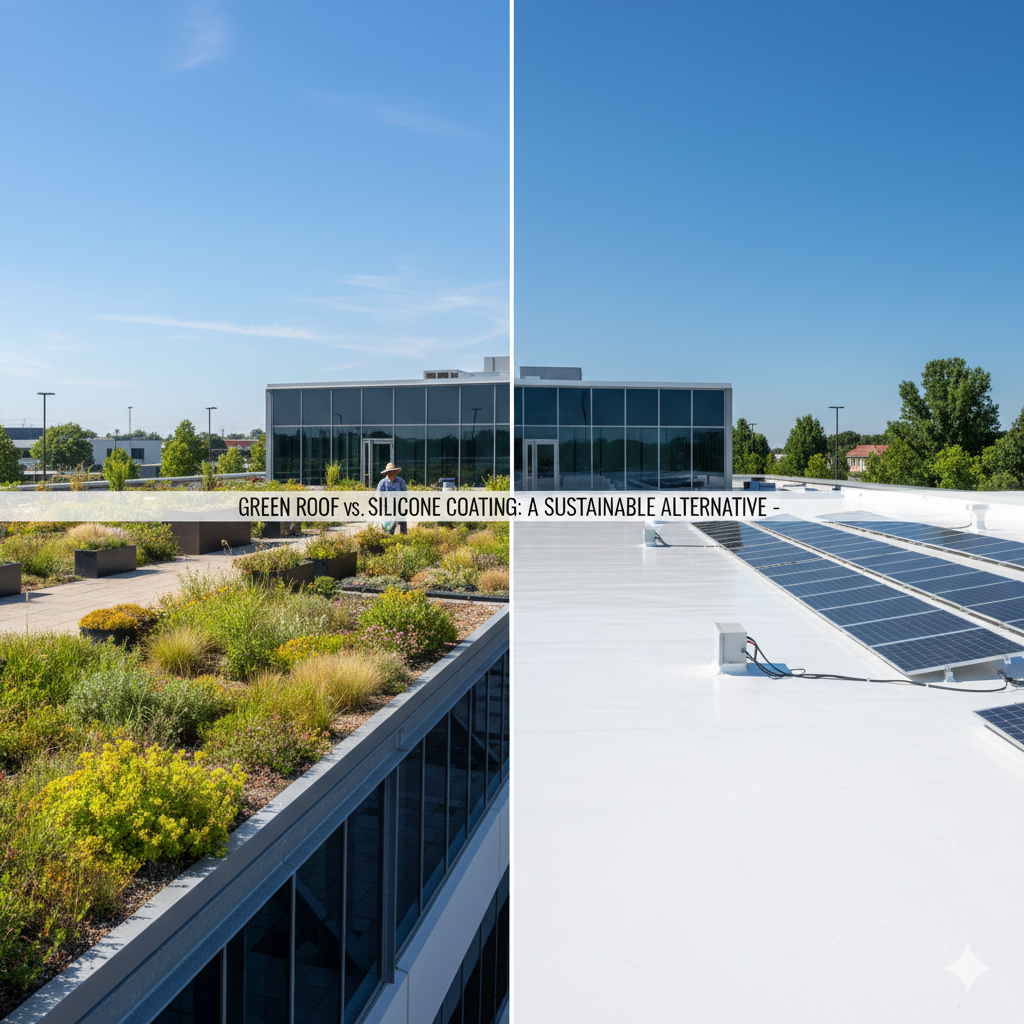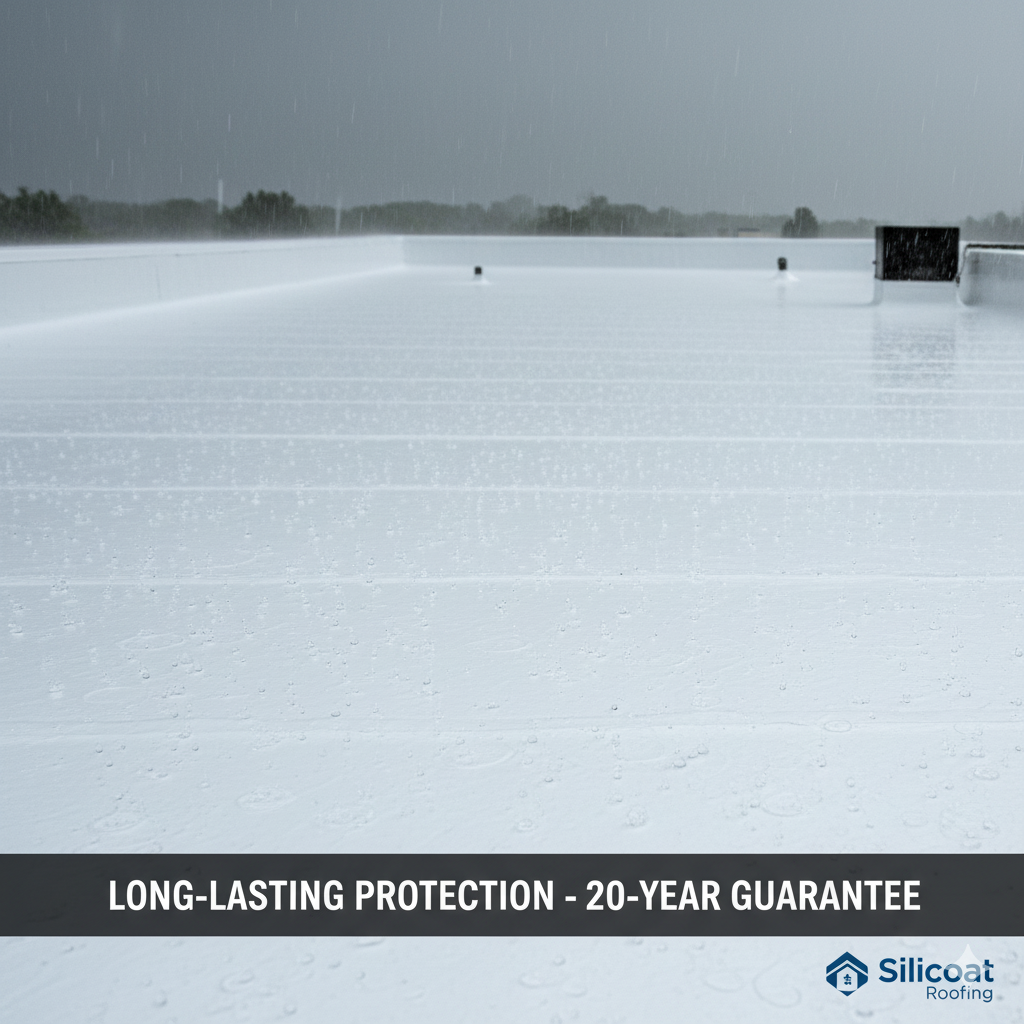
As businesses become more conscious of their environmental impact, many consider a green roof right away, as they are often praised for their eco-friendliness. While these installations look impressive, they can be impractical for many companies. Imagine a local warehouse trying to maintain a sprawling rooftop garden in an industrial park or a small retail space managing a mini-ecosystem on their roof. These concepts, though appealing, are far from feasible for most businesses due to high costs, maintenance demands, and structural challenges.
However, they aren’t the only solution for those looking to minimize their environmental footprint. At Silicoat Roofing, we offer an equally sustainable, cost-effective, and durable alternative: roof restoration using silicone membranes that provide a cooling effect. Our solution helps businesses achieve similar sustainability goals by focusing on energy efficiency, reduced waste, and long-term roof protection.
Which is the Best Sustainable Solution: Green Roof or Silicone Coating?
While green roofs have their advantages, including improved air quality and stormwater management, they come with certain challenges. Installation can be complex and expensive, and they often require overly complex maintenance to keep the plants and other organic elements healthy.
On the other hand, our restoration process is far less complex and much more cost-effective. It offers many of the same environmental benefits, such as reducing heat islands and lowering energy consumption, without the added complexity of maintaining vegetation. In this article, we will walk you through our process and explain why it serves as a sustainable alternative to green roofs.

The Sustainability of Silicoat Roofing’s Process:
- Reducing Waste through Restoration: One of the biggest environmental drawbacks of traditional roof replacements is the amount of waste generated. Tearing off an old roof means sending tons of materials to landfills, contributing to environmental degradation. That can be avoided by restoring existing flat and metal roofs with a high-quality silicone coating. This not only extends the life of your roof by up to 20 years but also drastically reduces waste, making it a greener choice. Learn more about our restoration process in here.
- Energy Efficiency with Cool Roofs: Like green roofs, our silicone coating reflects sunlight, helping to lower building temperatures. These “cool roofs” reduce the need for excessive air conditioning, cutting down on energy consumption and cooling costs. This energy efficiency is a cornerstone of sustainable building practices, allowing you to minimize your carbon footprint while saving on utility bills.
- Long-Lasting Solutions: Silicone roof coatings create a seamless, leak-free membrane that protects commercial buildings from rain, for instance. This durability means fewer repairs, less material usage, and a lower environmental impact over time. In fact, our roofs come with a 20-year leak-free guarantee, ensuring that your investment is not only environmentally sound but also economically beneficial.
- Cost-Effective: While green roofs represent a substantial investment, our silicone coating process is typically half the cost of a full roof replacement. This budget-friendly option delivers both financial savings and environmental benefits.
- Low Maintenance: Unlike green roofs, which need ongoing plant care, silicone coatings are virtually maintenance-free. They require only occasional inspections, offering a hassle-free solution with minimal upkeep.
- Versatility: Our silicone coating system can be applied to a range of roof types, including flat and metal roofs. This versatility makes it a suitable choice for diverse commercial buildings.
- Efficient Use of Resources: By opting for restoration over replacement, we conserve construction resources and reduce the environmental impact of transporting new materials, supporting sustainable building practices.
- Minimal Disruption: Our roof restoration process is quicker than installing a green roof, resulting in less disruption to business operations and a lower carbon footprint during installation.

Sustainable Roofing Trends 2025: Why Silicone Coatings Lead the Way
As sustainability becomes central to construction practices, both green roofs and silicone coatings have evolved significantly. In 2025, silicone roof coatings are being recognised not only for extending roof life but also for their measurable environmental benefits.
Recent innovations in high-solids silicone formulations allow for even better UV resistance and reflectivity, reducing roof surface temperatures by up to 30% and cutting building energy use by 10–15% annually. Many commercial facilities now use silicone coatings alongside solar panel systems to enhance efficiency and reduce heat absorption, creating a powerful combination of durability and clean energy.
Meanwhile, green roof systems have become easier to maintain through modular tray designs and improved drainage layers. However, they still require periodic irrigation, structural support, and professional upkeep costs that silicone coatings largely avoid.When comparing the two, silicone coatings remain the more cost-effective, low-maintenance, and energy-efficient option, especially for large commercial or industrial roofs seeking LEED credits or sustainability certifications.
A Sustainable Future with Silicoat Roofing
Choosing a sustainable roofing solution doesn’t have to mean opting for a complex, high-maintenance green roof like the ones you see in design magazines. like the ones you see in design magazines. At Silicoat Roofing, we offer an eco-friendly alternative that delivers the benefits of energy efficiency, waste reduction, and long-term durability. By opting for our roof restoration services, your business can enjoy a sustainable, cost-effective, and hassle-free roofing solution.
Contact us today for a free analysis and learn how our silicone-coated roofs can help you achieve your sustainability goals.
FAQs
Are silicone coatings environmentally friendly?
Yes. Modern silicone roof coatings are low-VOC, non-toxic, and help reduce landfill waste by restoring existing roofs instead of replacing them. They also improve a building’s energy efficiency through high solar reflectance and emissivity.
How long does a silicone roof coating last in 2025 formulations?
Newer silicone coating systems can last 20–25 years with proper maintenance and periodic reapplication, outperforming most single-ply or modified bitumen systems in both longevity and sustainability.
Can I combine a silicone coating with solar panels?
Absolutely. Silicone coatings provide a reflective, waterproof surface that pairs perfectly with solar panel installations. This combination reduces rooftop heat, optimises solar efficiency, and extends roof lifespan.
What are the main disadvantages of green roofs?
Green roofs offer great insulation and aesthetics but require higher upfront costs, structural load capacity, and routine maintenance. They’re also more susceptible to leaks if drainage or waterproofing isn’t correctly managed.
Which is better for large commercial properties?
For most commercial and industrial buildings, silicone coatings are the preferred choice; they’re lightweight, cost-efficient, easy to apply, and compliant with modern green building standards.


 Previous Post
Previous Post Next Post
Next Post